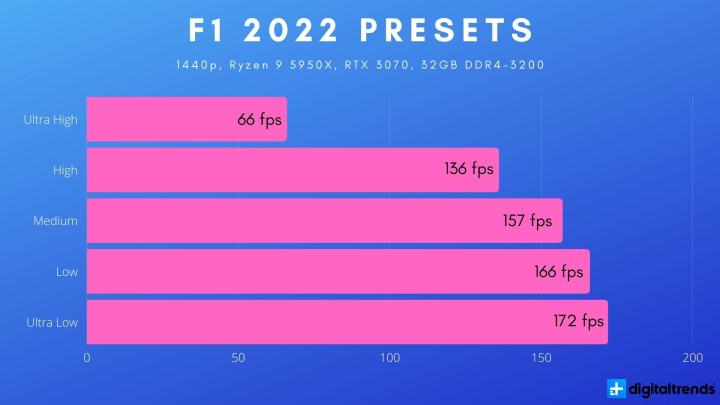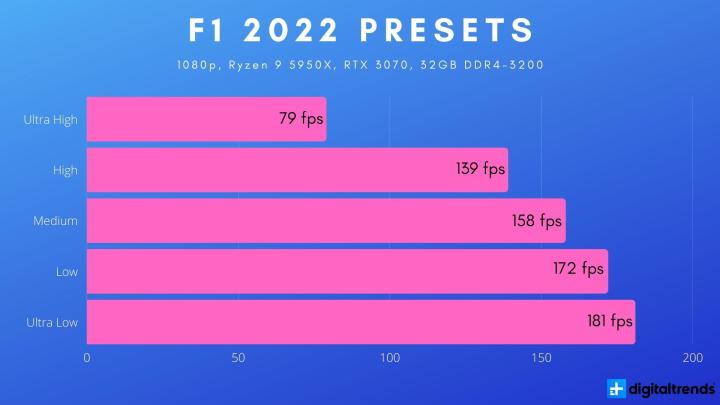F1 2022 is here, and like every annual release from the popular racing series, it’s a huge benchmark for PC performance. It’s demanding but well optimized. I booted up the DT test bench to find the best settings for F1 2022 so you can have a high frame rate.
You don’t need to do a lot of work to get F1 2022 working, especially with its multiple upscaling options. Ray tracing is a performance killer, though, and it’s not worth the frame rate dip for the vast majority of players.
The best settings for F1 2022
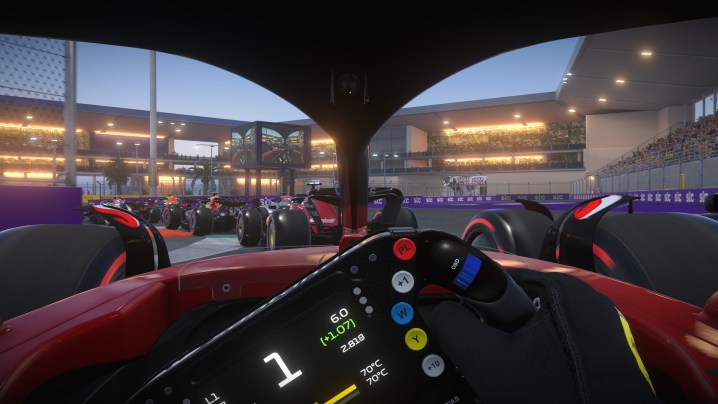
F1 2022 has a ton of graphics options, and none of them destroy performance or image quality. Ray tracing, which I’ll dig into later, is the main culprit of performance issues. Otherwise, you can stick with one of the game’s five presets to get an image you like, as well as use the dynamic resolution option in the Display settings menu to improve your frame rate. If you want to go at it on your own, here are the best settings for F1 2022:
- Lighting quality: Medium
- Post process: High
- Shadows: Medium
- Particles: Low
- Crowd: Medium
- Mirrors: High
- Car and helmet reflections: High
- Weather effects: High
- Ground cover: Medium
- Skidmarks: High
- Skidmarks blending: On
- Ambient occlusion: HBAO+
- Screen space reflections: Medium
- Asynchronous compute: On
- Texture streaming: High
I mainly optimized the settings with the best practices for PC game graphics. That means bumping down the shadows and lighting quality first, which both have the biggest impact on performance. I kept some of the smaller settings, like skidmarks and weather effects, turned up because of their limited performance hit. Feel free to bump down these settings if you’re running into issues, though.
Most people should stick around medium to high settings. I’ll go more in-depth in the benchmarks below, but F1 2022 shows diminishing returns beyond Medium for most settings. The Ultra Low preset isn’t too useful for the best graphics cards, offering only a slight bump over the Medium preset. With multiple upscaling options available, the only reason to go down to Ultra Low is if you’re running well below the recommended system requirements.
F1 2022 system requirements

F1 2022 doesn’t call for much, but the system requirements are a little misleading. At a minimum, an ancient Core i3-2130 or AMD FX 4300 is all you need, but I’d recommend sticking with the recommended specs when it comes to the CPU. F1 2022 is really CPU limited, so pairing a fast GPU with an older processor is sure to cause a PC bottleneck.
For graphics, even a GTX 1050 Ti should be enough at 1080p (though one of the best 1080p graphics cards is better). F1 2022 is really well optimized with ray tracing turned off, and you have a lot of bandwidth to improve your performance with dynamic resolution and the supersampling options in the game.
Ray tracing is the killer. You’ll need a GPU with DirectX 12 support to run the game, even if you want to turn ray tracing off. With ray tracing on, you’ll also need a much faster GPU. The system requirements only call for an RTX 2060 or RX 6700 XT, but I wouldn’t recommend ray tracing with anything less than an RTX 3070. Otherwise, you’ll likely have to settle for frame rates below 60 fps, especially if you want to run at a high resolution.
F1 2022 benchmarks (4K, 1440p, 1080p)
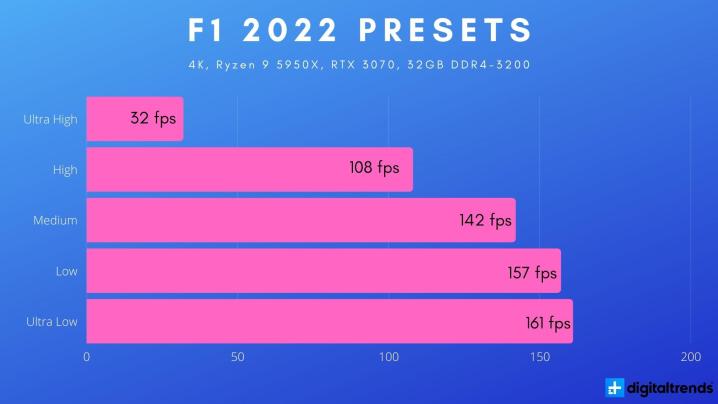
There are five graphics presets in F1 2022, and I tested all of them across 4K, 1440p, and 1080p with a Ryzen 9 5950X, RTX 3070, and 32GB of DDR4-3200 memory. Across resolutions, one preset is vastly slower than the others: Ultra High. This is the only preset that turns on ray tracing as a default option, and it’s extremely demanding.
At 4K, for example, you can see that the RTX 3070 just barely manages 30 fps with the Ultra High preset. The next step down results in a massive 238% increase in performance mostly on the back of turning ray tracing off. Medium offers a solid 32% bump over that, as well.
As mentioned, F1 2022 is fairly CPU limited, so performance returns start to fall off beyond the Medium preset. 1440p and 1080p illustrate this point clearly. They’re much closer in performance at each preset, and in some cases, such as the Medium preset, 1440p and 1080p show nearly identical performance. Take advantage of the lower settings if you have an older processor, but don’t count on them to improve your graphics performance.
Ray tracing in F1 2022
It should be clear by now, but ray tracing is extremely demanding in F1 2022. The most demanding Ultra High ray tracing preset can cause as much as a 63% slowdown in your average frame rate, so keep ray tracing turned off unless you have a super power graphics card like the RTX 3090 Ti, or if you take advantage of upscaling options.
Before getting to ray tracing performance, we need to talk about how it works in F1 2022. The game supports ray-traced shadows, reflections, transparent reflections, and ambient occlusion. You have a toggle for each of these settings, as well as three overall quality presets for ray tracing: Medium, High, and Ultra High. You can’t set the quality for individual settings, but the quality doesn’t have a huge impact on performance regardless.
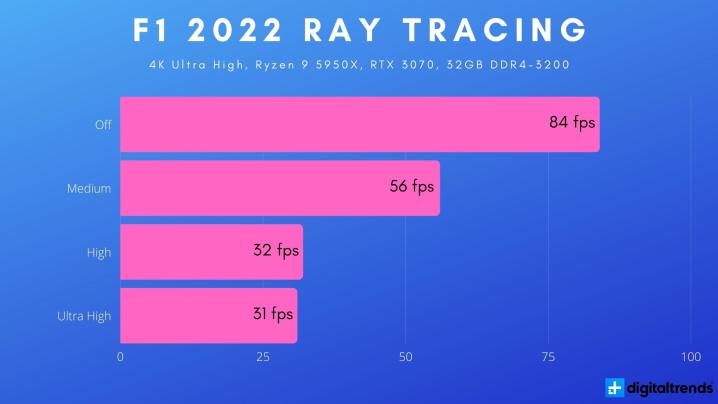
You can see that in the graph above. The High and Ultra High ray tracing presets have almost identical performance (the game actually uses the High settings for the Ultra High graphics preset). The Medium setting offers a solid 75% increase over the High preset, but it’s still far below just turning ray tracing off.
I’m struggling to see a difference between the quality modes for ray tracing, so if you turn it on, I’d recommend sticking with Medium quality. Most people should just turn ray tracing off, though, as the screen space reflections offer plenty of visual glitter without the massive hit to your frame rate.
DLSS and FSR in F1 2022
Ray tracing is demanding, but F1 2022 gives you options to combat the performance deficit. The game supports Nvidia’s Deep Learning Super Sampling (DLSS) and AMD’s FidelityFX Super Resolution (FSR). They both give you a way to improve performance by lowering the resolution the game renders at. F1 2022 includes its own dynamic resolution setting, too, though it doesn’t look nearly as nice as DLSS or FSR.
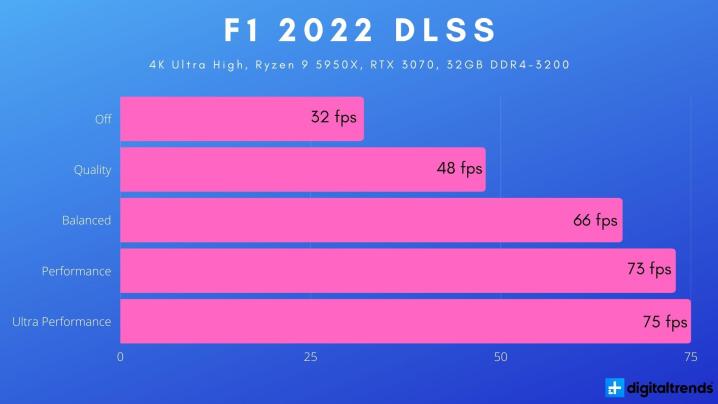
DLSS doesn’t offer the highest performance, but it’s the best option to maintain image quality. At 4K with the Ultra High preset, it offered a 50% boost in performance with the Quality mode. That’s big, but I’d recommend most people stick with the Balanced mode when using DLSS. It more than doubled my average frame rate without sacrificing image quality too much.
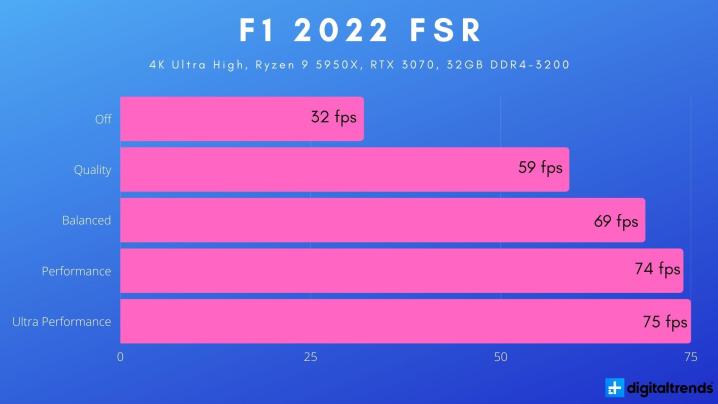
Unfortunately, DLSS only works on Nvidia’s RTX graphics cards. For everyone else, there’s FSR. F1 2022 only supports FSR 1.0, not the much better FSR 2.0 we’ve seen in games like Deathloop. I wouldn’t go beyond the Balanced preset for FSR 1.0 if you want decent image quality, though. FSR falls apart beyond that point.
An interesting trend with both DLSS and FSR is that they fall off past the Balanced mode. With F1 2022 being CPU limited the way it is, the more aggressive quality modes don’t offer as much of a bump in performance as they should.
Editors' Recommendations
- Helldivers 2 PC performance: best settings, performance, crashing
- Call of Duty Modern Warfare 3: best settings, benchmarks, and more
- These are the Diablo 4 settings to tweak for the best performance
- Resident Evil 4 Remake PC: best settings, ray tracing, FSR, and more
- Returnal PC: best settings, ray tracing, Steam Deck, and more


